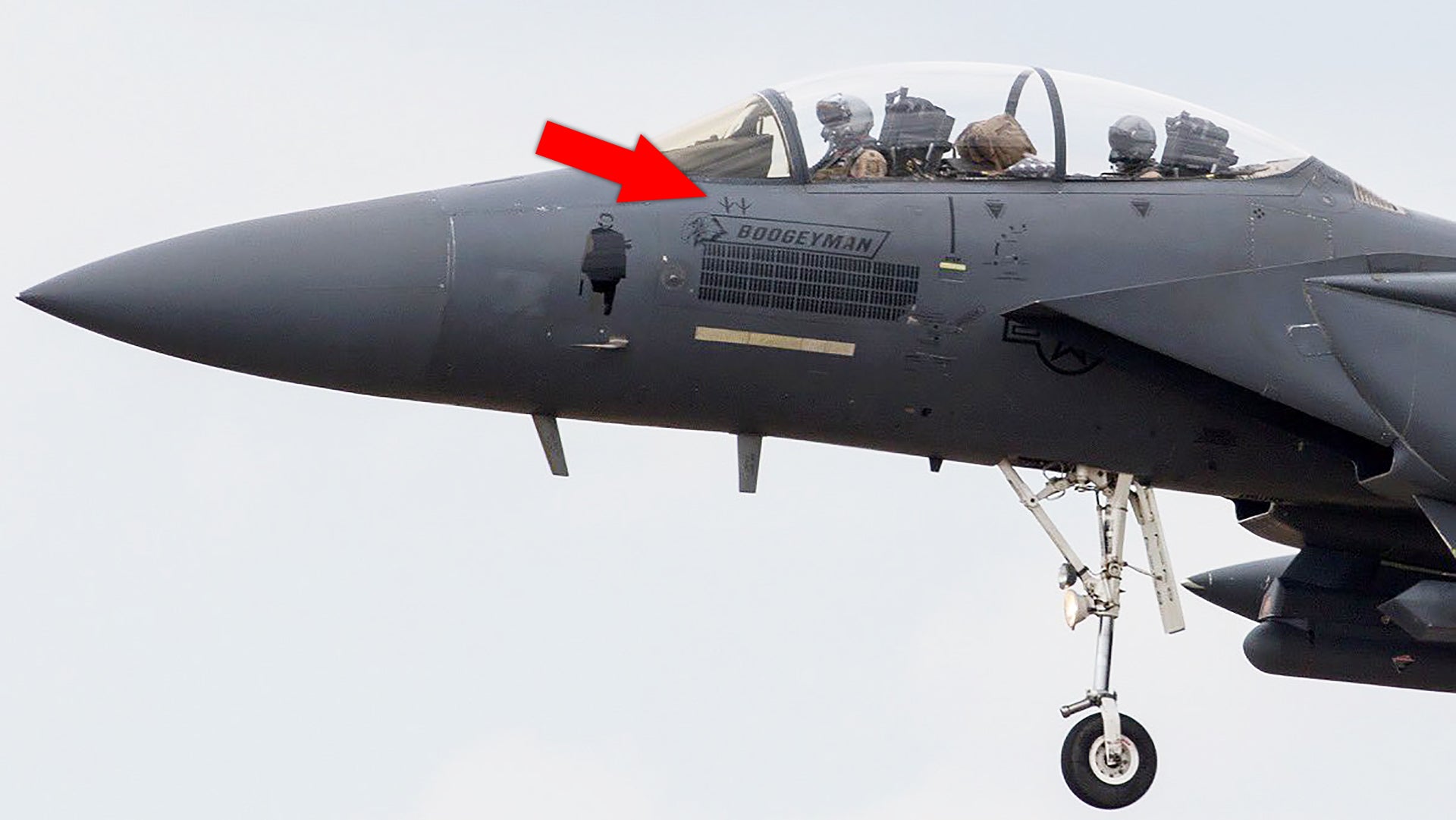A dozen F-15E Strike Eagles belonging to the 389th Fighter Squadron, the Thunderbolts, based at Mountain Home Air Force Base in Idaho are heading home from their rotational deployment to Jordan, stopping over at RAF Lakenheath in England on the way. For over half a year they have been supporting coalition operations over Iraq and Syria, and the combat the jets and their crews saw while executing those missions have manifested themselves via weapons markings on the aircraft’s nose area. Two of the jets that landed at Lakenheath had silhouettes of stealthy AGM-158 Joint Air-to-Surface Standoff Missiles (JASSM) among the numerous other bomb symbols.
We only know of two times that JASSMs have been employed in combat. The first was during coalition cruise missile strikes on Syria in 2018. In that case, the B-1B was the delivery system. The other time these weapons were used in anger was as part of the raid that killed supreme scumbag and ISIS founder Abu Bakr Al Baghdadi, which took place soon after the Thunderbolt jets arrived in Jordan last October. Shortly after the raid, we surmised that the delivery platforms for the JASSM strike were F-15Es out of Jordan. These images appear to largely confirm that.
Aviation Photographer Kevin Bell was at RAF Lakenheath to catch the Thunderbolts making the pit stop on their way back to Idaho on May 27th, 2020. After photographing the jets, he noticed the special mission marks on two of them, tail numbers 87-0173 and 87-0170.



The jets also had some pretty unique nose art painted on them, a practice that has become something of a rite of passage for Strike Eagle personnel that deploy to Jordan. The F-15E itself has become a staple at Jordan’s Muwaffaq Salti Air Base, having exclusively served as America’s go-to multi-role fighter with quick access to southern Syria and western Iraq while continuously deployed there. As such, they have taken part in some of the most crucial missions in the region, including the Al Baghdadi raid and multiple sorties defending the forward operating base used by American forces and its Syrian allies at At Tanf. When it comes to the Al Baghdadi mission, the F-15Es provided yet another layer of destructive force applied to the compound that housed him and goons, wiping it from the face of the earth so that it couldn’t become a shrine to the unique form of depraved hatred he built his ill-fated caliphate on.

The use of stealthy cruise missiles seemed like an odd weaponeering choice at the time the raid was announced, but as we have constantly stated over the years, American manned fixed-wing tactical aircraft do not often venture into western Syria due to the convoluted situation with Russia, Syria, and now Turkey, all using the airspace for their own various goals. Russia’s S-400 missile batteries at its air base south of Latakia are also a key reason for manned assets to avoid the area. U.S. drones, on the other hand, orbit over the area regularly.
Other factors also likely played into the choice to use the stealthy cruise missiles, such as bomb damage assessments from initial strikes. If the compound was not destroyed to a satisfactory degree, it may have prompted the order for the Strike Eagles to launch the missiles sometime after American forces had cleared out of the area safely. Why risk more aircraft when you don’t have to, especially when so much attention was now focused on that area? Moreover, all the other assets that would be required for a direct bombing mission, including search and rescue and airborne early warning and control aircraft, and much more, would not be needed for a standoff follow-on missile strike.
The use of JASSM would also provide more data for what is still a young and hugely promising missile system that had just seen its first combat use during the coalition missile strikes Syrian sites a year and a half prior. We summed up many of these thoughts in our original coverage that followed the raid.

Regardless, that makes these F-15Es, some of the oldest in the fleet, somewhat historic aircraft. Even the names on the jets that go along with their nose art—”Checkmate” and “Boogeyman”—could be a cryptic reference to the Al Baghdadi mission.
With all that in mind, with these images, it is all but outright officially confirmed that F-15Es did indeed execute the JASSM strikes on Al Baghdadi’s compound.
Well done Thunderbolts and welcome home!
A huge thanks to Kevin Bell for sharing his pictures with us. Make sure to check out more of his work here.
Contact the author: Tyler@thedrive.com
